Idioms in English Volume One - Step-by-Step Lesson Plans

Table of Contents
- Introduction
- Lesson One: In the Lab
- Lesson Two: Negotiations
- Lesson Three: Meeting Work Deadline
- Lesson Four: Challenges/Difficultie
- Lesson Five: Sales and Marketing
- Lesson Six: Communication Problems
- Lesson Seven: The New Accountant
- Lesson Eight: The Start Up
- Lesson Nine: A Bad Decision
- Lesson Ten: The Speech
- Lesson Eleven: In the Lab
- Classroom Expansion Options
Introduction
Background
Idioms like "think out of the box" and "make waves" are used frequently in conversations, email, presentations, and media in English. When students don't understand the idioms, they can feel left out of the conversation or presentation since the idiom is often the point of the sentence.
Focus
Our approach to teaching idioms also helps improve listening comprehension and pronunciation in English. We demonstrate how the concepts we teach in the Pronunciation in English program apply to idioms. The pronunciation notes on every idiom page demonstrate how stress (with content words), intonation (with focus words) and rhythm (with reduction and linking) apply to each idiom. Idioms in English – Volume One reinforces the concepts presented in the pronunciation program in a new context.
Grammar
The grammar in the idioms programs is implicit rather than explicit. So, when you get to a dictation page, if the idiom has a verb, there is usually a variation that will show a different construction. For example, the first sentence in the dictation for "fall through" uses "falls." ("If her plan falls through, she'll have to get another job.") The second sentence uses "fell." ("We thought the deal was going to happen, but it fell through.")
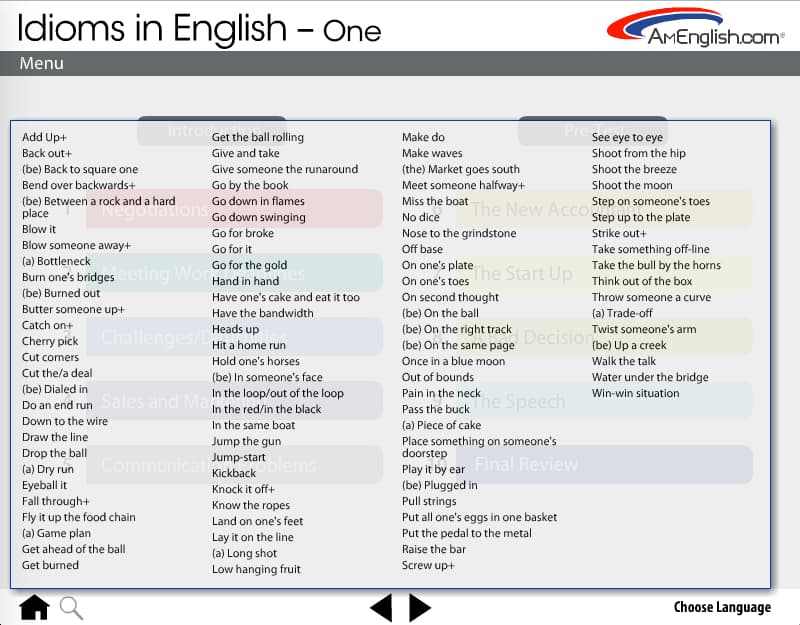
Appealing to multiple learning styles
Clicking on the focus word to make it turn red and show up in a larger font is a great way to remind you that the focus word is number one in terms of emphasis. If you are a visual learner, the larger font and the red is the best way to reinforce this concept. If you are a kinesthetic or tactile learner, you learn best by experiencing or doing something. Clicking on the correct word will be a better way to reinforce this concept for you. We try to cover all the bases. If you are an aural learner, then hearing the sentence when you click on the sound file will be the best reinforcement. If you are an oral learner, then you should take time to repeat the sentence aloud. Most of us benefit from a combination of practice activities that appeal to more than one learning style.

Navigation
At the main Table of Contents, there are now two kinds of 'roll over' flash menus:
- Mouse over the magnifying glass at the bottom of the tool bar and a program level index appears.
- Mouse over each chapter and a chapter level index appears.
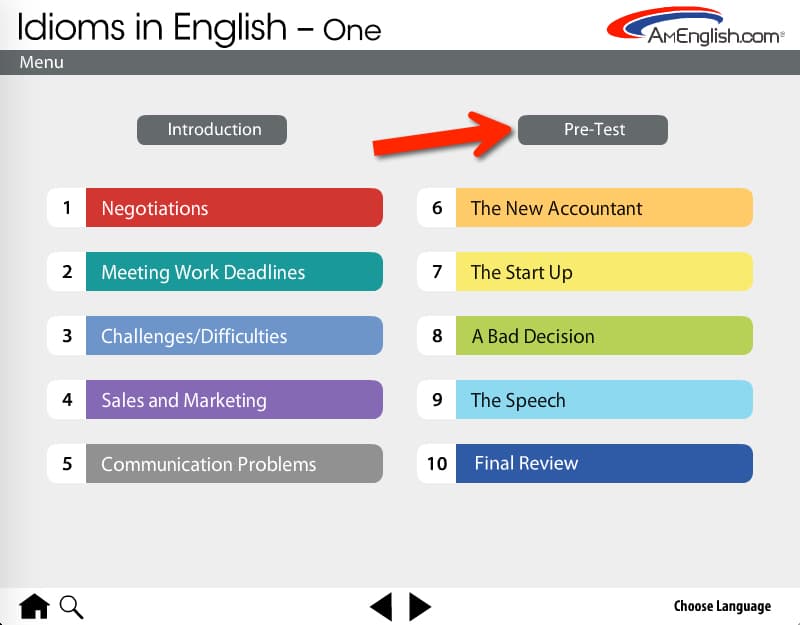
Organization
Pre-Test
The pre-test has multiple rotating versions. Students' pre-test scores can be compared to their final review scores to track their progress. Scores are available in the User Management System.
TOEFL® Skill Builder Buttons
Mouse over the TOEFL® skill builder buttons in each section to get specifics on how this program will help build skills required for the TOEFL® test.


Story/Dialogue: Listen
Students see a picture and listen to the story or dialog, which uses the idioms in context.

Quiz 1
The audio for each story/dialogue is followed by a quiz with listening comprehension questions about the main idea, the speaker's attitude, and supporting details. There is automatic scoring for this practice (this is similar to the listening comprehension practices for the TOEFL®).

Story/Dialogue: Read
Students see the text and can listen to the audio again for the story or dialog, which uses the idioms in context.
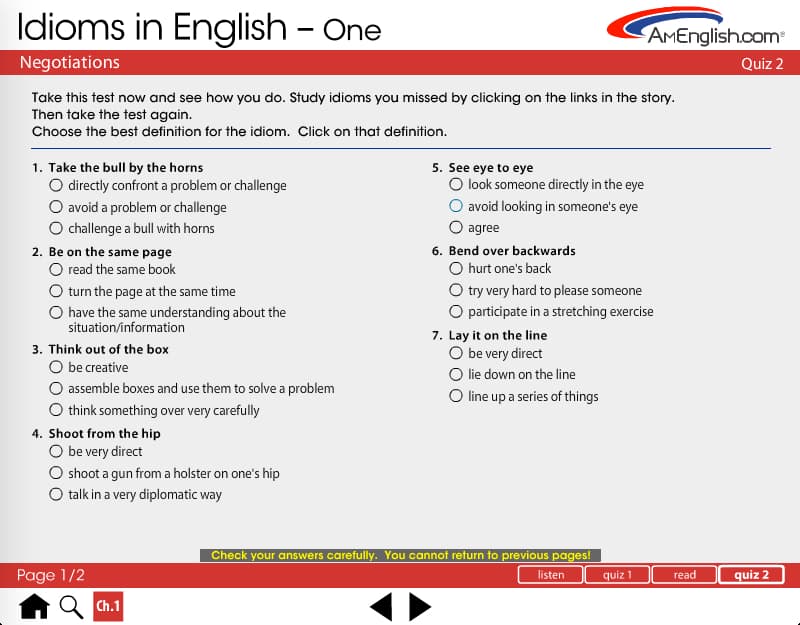
Quiz 2
The text for each story/dialogue is followed by a quiz on the definitions for each idiom. There is automatic scoring for this practice.
Individual Idioms
Individual idiom screens show:
- Idiom definition (with a translation option)
- Two example sentences using the idiom
- Pronunciation notes for each idiom

Phrasal Verbs
Each volume of Idioms in English has some phrasal verbs. Phrasal verbs are marked with a (+) sign in the alphabetical index and on the individual idiom page. Having both audio and text for the phrasal verbs in these programs will help students improve both their listening comprehension and spoken English for the TOEFL® test, which includes phrasal verbs.
Dictation practice/Focus word practice
Every idiom page is followed by a scored dictation practice and a focus word exercise, both of which help build listening comprehension.
Chapter review
At the end of every chapter is a scored dictation for the story/dialogue.
Final Review
The Final Review has multiple rotating versions. Students' final review scores can be compared to their pre-test scores to track their progress. Scores are available in the User Management System.

The final review features 4 different question types:
- Word scramble – checks grammar/syntax
- Dictation – checks listening comprehension
- Fill-in the blank – checks reading comprehension
- Multiple-choice – checks reading comprehension
It is a lot of fun to spot idioms in everyday conversations, in online media, and movies. Learning about idioms in English helps students become more fluent in the language as it used every day by native speakers.
Target Audience
This program was designed for students at the intermediate through advanced level.
Formats
The material is available online.
Customers
This program is used at schools like Reedley College and the University of South Carolina and companies like IBM and Deloitte to improve communication skills in English.
Lesson One: In the Lab

Pre-Test
Have students take the pre-test, so that there is a score to compare to the final review at the end of the program. Lower the affective filter by telling students that if they get a perfect score, they don't need to be in the class.
Notes for Teachers:
- This will give students a baseline and an awareness of their shortcomings.
- It will also intensify students' focus on the material in the programs.
- Teachers can compare scores on the Pre-test with the Final Review to measure improvement.

User Interface Tour
Spend some time in the lab with the program on the screen to give students a quick tour of the navigation. Make sure students know how to use the "Choose your language" button at the Table of Contents screen. Show students the "Using this Software" section in the Introduction. Take some time to show students how to control the audio, so they can start and stop in the middle of a story/dialogue and pick up where they left off.
Overview
- Show the table of contents with 9 stories/dialogues & Final Review
- Click on the magnifying glass at the bottom left of the screen to show them the alphabetical list of idioms in this volume.
- Show the first picture in Chapter 1 - Negotiations
- Let students listen to the dialogue and then go to the TOEFL® Listening Practice. Highlight the navigation at the bottom right of the screen.
- Next, take students to the "read" section where they can listen to the audio again and see the text. Show them "Quiz 2."
- Finally, show them one of the idiom screens from the first chapter. Highlight the buttons at the bottom right of the screen for "dictation" & "focus word" practice.
- Finally, take students back to the alphabetical index to show them the reviews for each chapter (see box at lower right of the screen).
On your own in the lab/Homework
- Review all of Chapter One: Negotiations
- Complete all of the quizzes and practices in this chapter

Lesson Two: Negotiations
In the classroom: Warm-up
Define the word "idiom" and elicit examples from the class.
An idiom is a group of words with a special meaning of its own that is not clear from the meanings of the individual words.
Note: Phrasal verbs, like "add up," are included in this program.
This can be a whole class exercise with teachers facilitating the discussion, or people can work in small groups or with partners to answer the questions.
Show the picture for chapter one (with no audio) or put the title of the chapter on the board: Negotiations
Ask students:
- Have you ever negotiated something?
- Do you like to negotiate?
- Do you think negotiations need to be balanced to work?
Note: The focus words for the idioms in this program were chosen based on common usage. The speaker can sometimes change the focus word in a phrase depending on what he/she wants to emphasize. For example, with the idiom, "put all one's eggs in one basket," the stress would usually be on "one," but if the speaker wants to emphasize the fact that all the money/time is invested in one place, the word "all" could become the focus word. Other idioms are not flexible, and the focus word does not change. An example would be: "a long shot."
Chapter Quiz Review
Roll over Chapter one to see the Table of Contents for Chapter One. Click on Quiz 2. Use this quiz to review the meanings for each idiom in this chapter. Divide the class into teams and have them compete against each other in answering the multiple choice questions. Keep score on the board. The team with the most points wins.
Presentation
Pronunciation focus: The schwa for "of"
Take a minute to focus on the schwa for "of" in the idiom "think out of the box." Project the individual idiom page for "think out of the box" on the board or just write the pronunciation sentence on the board:
We need to think out uh the box.
Model the schwa for "of" or play the sound file in the program and have the class repeat it:
Speaking practice
Go back to the main Table of Contents and mouse over the chapter level index for this chapter again. This time ask individual students to read the idioms in this chapter. Elicit the focus word for each idiom from the group. If you hear mistakes where students mispronounce a vowel sound or put too much stress on a function word like "the" or "it," take note and talk about it when the group is finished.
Grammar Focus
Elicit from the class which of these idioms have verbs. Have them supply the past tense of the verb. This will highlight irregular verbs and help prevent errors in the group practice that follows
Note the (+) sign next to idioms that are phrasal verbs. Remind students that the stress usually falls on the last part of a phrasal verb, the particle*.
*The last word in a phrasal verb is often called a particle.
Group practice
Have students work in small groups or with partners to make one sentence for each idiom. Consider having half of the groups work on sentences for the first half of the idioms and the other half of the class work on sentences for the second half.
Note: Advanced level students may want to try to write their own paragraph/story/dialogue using the idioms in context rather than just limiting themselves to sentences.
Monitor for Grammar/syntax problems
The instructor can monitor results during this time to check for grammar/syntax mistakes in the sentences.
Groups/Partners share
Groups will take turns sharing their sentences orally with the class. The rest of the class will give them a "thumbs up" if they hear the focus word in each sentence clearly.
Role Play
The instructor assigns role-plays to pairs of students that require using 4-5 idioms from the story. Here are a couple of scenarios:
Your teenager wants to stay out later on the weekend.
Characters: parent and teenager
You are looking for a reasonably priced used car for your commute.
Characters: customer and used car salesperson
Instructors can ask for volunteers to present their role-plays to the class or choose people to present.
Each member of the audience will write down the idioms used in each role-play, and the teacher will elicit the list from individuals at the end of each presentation to check listening comprehension.
Reflect
Take a moment to reflect on the lesson and share with a partner/the group what you've learned. How will you apply it to your communication in English?
On your own in the lab/Homework
- Review all of Chapter Two: Meeting Work Deadlines
- Complete all of the quizzes and practices in this chapter

Lesson Three: Meeting Work Deadlines
In the classroom: Warm-up
This can be a whole class exercise with teachers facilitating the discussion, or people can work in small groups or with partners to answer the questions.
Show the picture for chapter two (with no audio) or put the title of the chapter on the board: Meeting Work Deadlines
Ask students:
- Have you ever had a deadline at work/school?
- Did you meet the deadline?
- Do deadlines stress you out or motivate you?
Chapter Quiz Review
Roll over Chapter 2 to see the Table of Contents. Click on Quiz 2. Use this quiz to review the meanings for each idiom in this chapter. Divide the class into teams and have them compete against each other in answering the multiple choice questions. Keep score on the board. The team with the most points wins.
Presentation
Pronunciation focus: Linking
Take a minute to focus on the linking in the idiom "heads up." Project the individual idiom page for "heads up" on the board or just write the pronunciation sentence on the board:
I need a heads-up on any design changes.
Note that "s" in "heads" gets linked with the "u" in "up." This is a common pattern in English. When one word ends with a consonant sound and the next word begins with a vowel sound in the same phrase, they are linked together so they sound like one word.
Model the linking or play the sound file in the program and have the class repeat it:
I need a heads-up on any design changes.
Speaking practice
Go back to the main Table of Contents and mouse over the chapter level index for this chapter again. This time ask individual students to read the idioms in this chapter. Elicit the focus word for each idiom from the group. If you hear mistakes where students mispronounce a vowel sound or put too much stress on a function word like "the" or "it," take note and talk about it when the group is finished.
Grammar Focus
Elicit from the class which of these idioms have verbs. Have them supply the past tense of the verb. This will highlight irregular verbs and help prevent errors in the group practice that follows
Note the (+) sign next to idioms that are phrasal verbs.
Group practice
Have students work in small groups or with partners to make one sentence for each idiom. Consider having half of the groups work on sentences for the first half of the idioms and the other half of the class work on sentences for the second half.
Note: Advanced level students may want to try to write their own paragraph/story/dialogue using the idioms in context rather than just limiting themselves to sentences.
Monitor for Grammar/syntax problems
The instructor can monitor results during this time to check for grammar/syntax mistakes in the sentences.
Groups/Partners share
Groups will take turns sharing their sentences orally with the class. The rest of the class will give them a "thumbs up" if they hear the focus word in each sentence clearly.
Role-Play
The instructor assigns role-plays to pairs of students that require using 4-5 idioms from the story. Here are a couple of scenarios:
Two engineers at a small company are talking about an upcoming release deadline for their new game.
Characters: 2 engineers
Two managers at a company that makes mobile phones are talking about a deadline for their new product.
Characters: Two managers
Instructors can ask for volunteers to present their role-plays to the class or choose people to present.
Each member of the audience will write down the idioms used in each role-play, and the teacher will elicit the list from individuals at the end of each presentation to check listening comprehension.
Reflect
Take a moment to reflect on the lesson and share with a partner/the group what you've learned. How will you apply it to your communication in English?
On your own in the lab/Homework
- Review all of Chapter Three: Challenges/Difficulties
- Complete all of the quizzes and practices in this chapter

Lesson Four: Challenges/Difficulties
In the classroom: Warm-up
This can be a whole class exercise with teachers facilitating the discussion, or people can work in small groups or with partners to answer the questions.
Show the picture for chapter three (with no audio) or put the title of the chapter on the board: Challenges/Difficulties
Ask students:
- How do you usually respond to challenges/difficulties?
- Who do you talk to when you have challenges/difficulties?
- Do you think it's useful to talk to someone else about a challenge or problem in your life?
Chapter Quiz Review
Roll over Chapter 3 to see the Table of Contents. Click on Quiz 2. Use this quiz to review the meanings for each idiom in this chapter. Divide the class into teams and have them compete against each other in answering the multiple choice questions. Keep score on the board. The team with the most points wins.
Presentation
Pronunciation focus: Reduction
Take a minute to focus on the reduction in the idiom "between a rock and a hard place." Project the individual idiom page for "between a rock and a hard place" on the board or just write the pronunciation sentence on the board:
He's between a rock 'n a hard place.
Note that the word "and" is reduced to "n."
Model the reduction or play the sound file in the program and have the class repeat it:
He's between a rock 'n a hard place.
Speaking practice
Go back to the main Table of Contents and mouse over the chapter level index for this chapter again. This time ask individual students to read the idioms in this chapter. Elicit the focus word for each idiom from the group. If you hear mistakes where students mispronounce a vowel sound or put too much stress on a function word like "the" or "it," take note and talk about it when the group is finished.
Grammar Focus
Elicit from the class which of these idioms have verbs. Have them supply the past tense of the verb. This will highlight irregular verbs and help prevent errors in the group practice that follows
Note the (+) sign next to idioms that are phrasal verbs.
Group practice
Have students work in small groups or with partners to make one sentence for each idiom. Consider having half of the groups work on sentences for the first half of the idioms and the other half of the class work on sentences for the second half.
Note: Advanced level students may want to try to write their own paragraph/story/dialogue using the idioms in context rather than just limiting themselves to sentences.
Monitor for Grammar/syntax problems
The instructor can monitor results during this time to check for grammar/syntax mistakes in the sentences.
Groups/Partners share
Groups will take turns sharing their sentences orally with the class. The rest of the class will give them a "thumbs up" if they hear the focus word in each sentence clearly.
Role-Play
The instructor assigns role-plays to pairs of students that require using 4-5 idioms from the story. Here are a couple of scenarios:
Your boss has given you more responsibility at work, but you have not gotten a raise.
Characters: underpaid worker and friend
You've been asked to cut costs in your department, which may mean laying off some people.
Characters: worker and co-worker
Instructors can ask for volunteers to present their role-plays to the class or choose people to present.
Each member of the audience will write down the idioms used in each role-play, and the teacher will elicit the list from individuals at the end of each presentation to check listening comprehension.
Reflect
Take a moment to reflect on the lesson and share with a partner/the group what you've learned. How will you apply it to your communication in English?
On your own in the lab/Homework
- Review all of Chapter Four: Sales and Marketing
- Complete all of the quizzes and practices in this chapter

Lesson Five: Sales and Marketing
In the classroom: Warm-up
This can be a whole class exercise with teachers facilitating the discussion, or people can work in small groups or with partners to answer the questions.
Show the picture for chapter four (with no audio) or put the title of the chapter on the board: Sales and Marketing
Ask students:
- Are you interested in marketing or sales?
- How important do you think marketing is for new products?
- Name some companies that you think have good marketing or advertising.
- Do you think the company with the best products will always be the one that dominates the market?
Chapter Quiz Review
At the main Table of Contents screen, roll over Chapter 4 to see the Chapter level Table of Contents. Click on Quiz 2. Use this quiz to review the meanings for each idiom in this chapter. Divide the class into teams and have them compete against each other in answering the multiple choice questions. Keep score on the board. The team with the most points wins.
Presentation
Pronunciation focus: Linking
Take a minute to focus on the linking in the idiom "be plugged in." Project the individual idiom page for "be plugged in" on the board or just write the pronunciation sentence on the board:
He is really plugged-in.
Note that "d" in "plugged" gets linked with the "i" in "in." This is a common pattern in English. When one word ends with a consonant sound and the next word begins with a vowel sound in the same phrase, they are linked together so they sound like one word.
Model the linking or play the sound file in the program and have the class repeat it:
He is really plugged-in.
Speaking practice
Go back to the main Table of Contents and mouse over the chapter level index for Chapter 4 again. This time ask individual students to read the idioms in this chapter. Elicit the focus word for each idiom from the group. If you hear mistakes where students mispronounce a vowel sound or put too much stress on a function word like "the" or "it," take note and talk about it when the group is finished.
Grammar Focus
Elicit from the class which of these idioms have verbs. Have them supply the past tense of the verb. This will highlight irregular verbs and help prevent errors in the group practice that follows
Note the (+) sign next to idioms that are phrasal verbs.
Group practice
Have students work in small groups or with partners to make one sentence for each idiom. Consider having half of the groups work on sentences for the first half of the idioms and the other half of the class work on sentences for the second half.
Note: Advanced level students may want to try to write their own paragraph/story/dialogue using the idioms in context rather than just limiting themselves to sentences.
Monitor for Grammar/syntax problems
The instructor can monitor results during this time to check for grammar/syntax mistakes in the sentences.
Groups/Partners share
Groups will take turns sharing their sentences orally with the class. The rest of the class will give them a "thumbs up" if they hear the focus word in each sentence clearly.
Role-Play
The instructor assigns role-plays to pairs* of students that require using 4-5 idioms from the story. Here are a couple of scenarios:
Two employees are talking about the outlook for their small start-up.
Characters: 2 employees
Two news broadcasters are talking about the prospects of two companies that are competing for customers.
Characters: two news broadcasters
Instructors can ask for volunteers to present their role-plays to the class or choose people to present.
Each member of the audience will write down the idioms used in each role-play, and the teacher will elicit the list from individuals at the end of each presentation to check listening comprehension.
Reflect
Take a moment to reflect on the lesson and share with a partner/the group what you've learned. How will you apply it to your communication in English?
On your own in the lab/Homework
- Review all of Chapter Five: Communication Problems
- Complete all of the quizzes and practices in this chapter

Lesson Six: Communication Problems
In the Classroom: Warm-up
This can be a whole class exercise with teachers facilitating the discussion, or people can work in small groups or with partners to answer the questions.
Show the picture for chapter five (with no audio) or put the title of the chapter on the board: Communication Problems
Ask students:
- Have you ever had a communication problem with someone?
- What happened?
- Were you able to work it out? How?
Chapter Quiz Review
At the main Table of Contents screen, roll over Chapter 5 to see the chapter level Table of Contents. Click on Quiz 2. Use this quiz to review the meanings for each idiom in this chapter. Divide the class into teams and have them compete against each other in answering the multiple choice questions. Keep score on the board. The team with the most points wins.
Presentation
Pronunciation focus: Linking
Take a minute to focus on the linking in the idiom "step up to the plate." Project the individual idiom page for "step up to the plate" on the board or just write the pronunciation sentence on the board:
I hope he will step-up to the plate.
Note that "p" in "step" gets linked with the "u" in "up." This is a common pattern in English. When one word ends with a consonant sound and the next word begins with a vowel sound in the same phrase, they are linked together so they sound like one word.
Model the linking or play the sound file in the program and have the class repeat it:
I hope he will step-up to the plate.
Speaking practice
Go back to the main Table of Contents and mouse over the chapter level index for Chapter 5 again. This time ask individual students to read the idioms in this chapter. Elicit the focus word for each idiom from the group. If you hear mistakes where students mispronounce a vowel sound or put too much stress on a function word like "the" or "it," take note and talk about it when the group is finished.
Grammar Focus
Elicit from the class which of these idioms have verbs. Have them supply the past tense of the verb. This will highlight irregular verbs and help prevent errors in the group practice that follows
Note the (+) sign next to idioms that are phrasal verbs.
Group practice
Have students work in small groups or with partners to make one sentence for each idiom. Consider having half of the groups work on sentences for the first half of the idioms and the other half of the class work on sentences for the second half.
Note: Advanced level students may want to try to write their own paragraph/story/dialogue using the idioms in context rather than just limiting themselves to sentences.
Monitor for Grammar/syntax problems
The instructor can monitor results during this time to check for grammar/syntax mistakes in the sentences.
Groups/Partners share
Groups will take turns sharing their sentences orally with the class. The rest of the class will give them a "thumbs up" if they hear the focus word in each sentence clearly.
Role-Play
The instructor assigns role-plays to pairs* of students that require using 4-5 idioms from the story. Here are a couple of scenarios:
You are telling a friend about a meeting with communication problems.
Characters: 2 friends
You are participating in a counseling session about resolving communication problems between you and your spouse.
*Note: this role-play is for 3 people
Characters: husband & wife & counselor
Instructors can ask for volunteers to present their role-plays to the class or choose people to present.
Each member of the audience will write down the idioms used in each role-play, and the teacher will elicit the list from individuals at the end of each presentation to check listening comprehension.
Reflect
Take a moment to reflect on the lesson and share with a partner/the group what you've learned. How will you apply it to your communication in English?
On your own in the lab/Homework
- Review all of Chapter Six: The New Accountant
- Complete all of the quizzes and practices in this chapter

Lesson Seven: The New Accountant
In the classroom: Warm-up
This can be a whole class exercise with teachers facilitating the discussion, or people can work in small groups or with partners to answer the questions.
Show the picture for chapter six (with no audio) or put the title of the chapter on the board: The New Accountant
Ask students:
- Do you keep track of your expenses?
- Is accounting a job that would interest you?
- Do you enjoy working with numbers?
Chapter Quiz Review
At the main Table of Contents screen, roll over Chapter 6 to see the chapter level Table of Contents. Click on Quiz 2. Use this quiz to review the meanings for each idiom in this chapter. Divide the class into teams and have them compete against each other in answering the multiple choice questions. Keep score on the board. The team with the most points wins.
Presentation
Pronunciation focus: Linking
Take a minute to focus on the linking in the idiom "eyeball it." Project the individual idiom page for "eyeball it" on the board or just write the pronunciation sentence on the board:
I'll have to eyeball-it.
Note that "l" in "eyeball" gets linked with the "i" in "it." This is a common pattern in English. When one word ends with a consonant sound and the next word begins with a vowel sound in the same phrase, they are linked together so they sound like one word.
Model the linking or play the sound file in the program and have the class repeat it:
I'll have to eyeball-it.
Speaking practice
Go back to the main Table of Contents and mouse over the chapter level index for this chapter again. This time ask individual students to read the idioms in this chapter. Elicit the focus word for each idiom from the group. If you hear mistakes where students mispronounce a vowel sound or put too much stress on a function word like "the" or "it," take note and talk about it when the group is finished.
Grammar Focus
Elicit from the class which of these idioms have verbs. Have them supply the past tense of the verb. This will highlight irregular verbs and help prevent errors in the group practice that follows.
Note the (+) sign next to idioms that are phrasal verbs.
Group practice
Have students work in small groups or with partners to make one sentence for each idiom. Consider having half of the groups work on sentences for the first half of the idioms and the other half of the class work on sentences for the second half.
Note: Advanced level students may want to try to write their own paragraph/story/dialogue using the idioms in context rather than just limiting themselves to sentences.
Monitor for Grammar/syntax problems
The instructor can monitor results during this time to check for grammar/syntax mistakes in the sentences.
Groups/Partners share
Groups will take turns sharing their sentences orally with the class. The rest of the class will give them a "thumbs up" if they hear the focus word in each sentence clearly.
Role-Play
The instructor assigns role-plays to pairs of students that require using 4-5 idioms from the story. Here are a couple of scenarios:
Your company is looking for a new accountant. They had to fire the old one for illegal activities.
Characters: 2 co-workers
You are applying for a job at a company as an accountant.
Characters: interviewer & potential hire (accountant)
Instructors can ask for volunteers to present their role-plays to the class or choose people to present.
Each member of the audience will write down the idioms used in each role-play, and the teacher will elicit the list from individuals at the end of each presentation to check listening comprehension.
Reflect
Take a moment to reflect on the lesson and share with a partner/the group what you've learned. How will you apply it to your communication in English?
On your own in the lab/Homework
- Review all of Chapter Seven: The Start Up
- Complete all of the quizzes and practices in this chapter
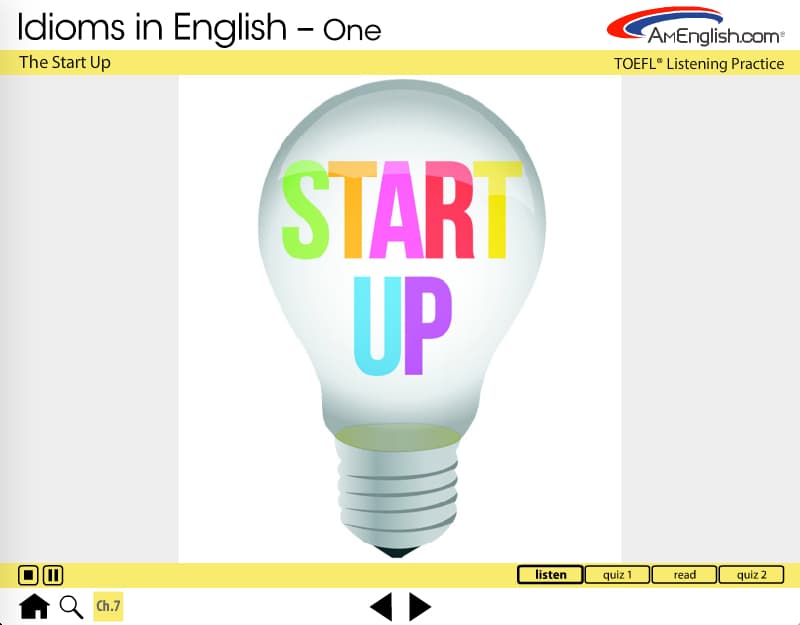
Lesson Eight: The Start Up
In the classroom: Warm-up
This can be a whole class exercise with teachers facilitating the discussion, or people can work in small groups or with partners to answer the questions.
Show the picture for chapter seven (with no audio) or put the title of the chapter on the board: The Start Up
Ask students:
- Would you rather work for an established company or a start up?
- What are the advantages/disadvantages of each kind of company?
- Name one company where you'd like to work. Why?
Chapter Quiz Review
At the main Table of Contents screen, roll over Chapter 7 to see the chapter level Table of Contents. Click on Quiz 2. Use this quiz to review the meanings for each idiom in this chapter. Divide the class into teams and have them compete against each other in answering the multiple choice questions. Keep score on the board. The team with the most points wins.
Presentation
Pronunciation focus: Linking
Take a minute to focus on the linking in the idiom "land on one's feet." Project the individual idiom page for "land on one's feet" on the board or just write the pronunciation sentence on the board:
He landed-on his feet.
Note that "d" in "landed" gets linked with the "o" in "on." This is a common pattern in English. When one word ends with a consonant sound and the next word begins with a vowel sound in the same phrase, they are linked together so they sound like one word.
Model the linking or play the sound file in the program and have the class repeat it:
He landed-on his feet.
Speaking practice
Go back to the main Table of Contents and mouse over the chapter level index for this chapter again. This time ask individual students to read the idioms in this chapter. Elicit the focus word for each idiom from the group. If you hear mistakes where students mispronounce a vowel sound or put too much stress on a function word like "the" or "it," take note and talk about it when the group is finished.
Grammar Focus
Elicit from the class which of these idioms have verbs. Have them supply the past tense of the verb. This will highlight irregular verbs and help prevent errors in the group practice that follows
Note the (+) sign next to idioms that are phrasal verbs.
Group practice
Have students work in small groups or with partners to make one sentence for each idiom. Consider having half of the groups work on sentences for the first half of the idioms and the other half of the class work on sentences for the second half.
Note: Advanced level students may want to try to write their own paragraph/story/dialogue using the idioms in context rather than just limiting themselves to sentences.
Monitor for Grammar/syntax problems
The instructor can monitor results during this time to check for grammar/syntax mistakes in the sentences.
Groups/Partners share
Groups will take turns sharing their sentences orally with the class. The rest of the class will give them a "thumbs up" if they hear the focus word in each sentence clearly.
Role-Play
The instructor assigns role-plays to pairs of students that require using 4-5 idioms from the story. Here are a couple of scenarios:
You are talking with a friend about leaving your established company to take a job at a start up with stock options. It's a risk, but you think it may be worth it.
Characters: 2 friends
You and a co-worker are talking about a friend who left his job at a start up to go to a more established company. He made the decision to change jobs based on the hours. He was working very long hours at the start up, and now his wife is pregnant, and they will have a new baby soon. He can work a more reasonable schedule at the established company.
Characters: 2 co-workers
Instructors can ask for volunteers to present their role-plays to the class or choose people to present.
Each member of the audience will write down the idioms used in each role-play, and the teacher will elicit the list from individuals at the end of each presentation to check listening comprehension.
Reflect
Take a moment to reflect on the lesson and share with a partner/the group what you've learned. How will you apply it to your communication in English?
On your own in the lab/Homework
- Review all of Chapter Eight: A Bad Decision
- Complete all of the quizzes and practices in this chapter

Lesson Nine: A Bad Decision
In the classroom: Warm-up
This can be a whole class exercise with teachers facilitating the discussion, or people can work in small groups or with partners to answer the questions.
Show the picture for chapter eight (with no audio) or put the title of the chapter on the board: A Bad Decision
Ask students:
- Have you ever made a bad decision?
- Did you take responsibility for the bad decision?
- What was the outcome?
Chapter Quiz Review
At the main Table of Contents screen, roll over Chapter 8 to see the chapter level Table of Contents. Click on Quiz 2. Use this quiz to review the meanings for each idiom in this chapter. Divide the class into teams and have them compete against each other in answering the multiple choice questions. Keep score on the board. The team with the most points wins.
Presentation
Pronunciation focus: Reduction
Take a minute to focus on the reduction in the idiom "have one's cake and eat it too." Project the individual idiom page for "have one's cake and eat it too" on the board or just write the pronunciation sentence on the board:
He got to have his cake 'n eat it too.
Note that the word "and" is reduced to "n."
Model the reduction or play the sound file in the program and have the class repeat it:
He got to have his cake 'n eat it too.
Speaking practice
Go back to the main Table of Contents and mouse over the chapter level index for this chapter again. This time ask individual students to read the idioms in this chapter. Elicit the focus word for each idiom from the group. If you hear mistakes where students mispronounce a vowel sound or put too much stress on a function word like "the" or "it," take note and talk about it when the group is finished.
Grammar Focus
Elicit from the class which of these idioms have verbs. Have them supply the past tense of the verb. This will highlight irregular verbs and help prevent errors in the group practice that follows.
Note the (+) sign next to idioms that are phrasal verbs.
Group practice
Have students work in small groups or with partners to make one sentence for each idiom. Consider having half of the groups work on sentences for the first half of the idioms and the other half of the class work on sentences for the second half.
Note: Advanced level students may want to try to write their own paragraph/story/dialogue using the idioms in context rather than just limiting themselves to sentences.
Monitor for Grammar/syntax problems
The instructor can monitor results during this time to check for grammar/syntax mistakes in the sentences.
Groups/Partners share
Groups will take turns sharing their sentences orally with the class. The rest of the class will give them a "thumbs up" if they hear the focus word in each sentence clearly.
Role-Play
The instructor assigns role-plays to pairs of students that require using 4-5 idioms from the story. Here are a couple of scenarios:
A child asks his mother's permission to go to the mall with friends and she says "no." Then, that child goes to his father and asks the same question, and his father says "yes." Now the parents are having an argument about this.
Characters: mother and father
You have an employee who went to your boss to ask for something that you already told him he couldn't have. You are upset that your employee went around you to your boss. You are talking about it together.
Characters: employee and manager
Instructors can ask for volunteers to present their role-plays to the class or choose people to present.
Each member of the audience will write down the idioms used in each role-play, and the teacher will elicit the list from individuals at the end of each presentation to check listening comprehension.
Reflect
Take a moment to reflect on the lesson and share with a partner/the group what you've learned. How will you apply it to your communication in English?
On your own in the lab/Homework
- Review all of Chapter Nine: The Speech
- Complete all of the quizzes and practices in this chapter

Lesson Ten: The Speech
In the classroom: Warm-up
This can be a whole class exercise with teachers facilitating the discussion, or people can work in small groups or with partners to answer the questions.
Show the picture for chapter nine (with no audio) or put the title of the chapter on the board: The Speech
Ask students:
- Have you ever had to make a speech?
- Does public speaking make you nervous?
- What do you think it takes to be a good speaker?
Chapter Quiz Review
At the main Table of Contents screen, roll over Chapter 9 to see the chapter level Table of Contents. Click on Quiz 2. Use this quiz to review the meanings for each idiom in this chapter. Divide the class into teams and have them compete against each other in answering the multiple choice questions. Keep score on the board. The team with the most points wins.
Presentation
Pronunciation focus: The schwa for "of"
Take a minute to focus on the schwa for "of" in the idiom "a piece of cake." Project the individual idiom page for "a piece of cake" on the board or just write the pronunciation sentence on the board:
It's a piece uh cake.
Note that the word "of" is reduced to a schwa or "uh" sound when it comes before a word that starts with a consonant sound, "cake." The schwa sound is short and unstressed. You can hear it in the words "above" and "banana."
Model the schwa for "of" or play the sound file in the program and have the class repeat it:
It's a piece uh cake.
Speaking practice
Go back to the main Table of Contents and mouse over the chapter level index for this chapter again. This time ask individual students to read the idioms in this chapter. Elicit the focus word for each idiom from the group. If you hear mistakes where students mispronounce a vowel sound or put too much stress on a function word like "the" or "it," take note and talk about it when the group is finished.
Grammar Focus
Elicit from the class which of these idioms have verbs. Have them supply the past tense of the verb. This will highlight irregular verbs and help prevent errors in the group practice that follows.
Note the (+) sign next to idioms that are phrasal verbs.
Group practice
Have students work in small groups or with partners to make one sentence for each idiom. Consider having half of the groups work on sentences for the first half of the idioms and the other half of the class work on sentences for the second half.
Note: Advanced level students may want to try to write their own paragraph/story/dialogue using the idioms in context rather than just limiting themselves to sentences.
Monitor for Grammar/syntax problems
The instructor can monitor results during this time to check for grammar/syntax mistakes in the sentences.
Groups/Partners share
Groups will take turns sharing their sentences orally with the class. The rest of the class will give them a "thumbs up" if they hear the focus word in each sentence clearly.
Role-Play
The instructor assigns role-plays to pairs of students that require using 3-4 idioms from the story. Here are a couple of scenarios:
Your teacher has asked you make a speech in front of the class, but you feel very nervous about the idea.
Characters: teacher and student
Your manager has asked you to make a presentation to a new client, and this is the first time you've done something like this.
Characters: manager and employee
Instructors can ask for volunteers to present their role-plays to the class or choose people to present.
Each member of the audience will write down the idioms used in each role-play, and the teacher will elicit the list from individuals at the end of each presentation to check listening comprehension.
Reflect
Take a moment to reflect on the lesson and share with a partner/the group what you've learned. How will you apply it to your communication in English?
On your own in the lab/Homework
Take the Final Review
Note that the Word Scramble in the Final Review checks grammar/syntax by requiring students to:
- Put the words in the idiom in the correct order
- Choose the correct word form for some idioms
- Choose the correct article for some idioms
- Choose the correct verb tense for some idioms
Students could benefit from taking the Final Review more than once as it has rotating sections. If there is time, teachers could take students into the language lab on two separate days to take the Final Review. The second day would be a challenge to see if they can improve their scores
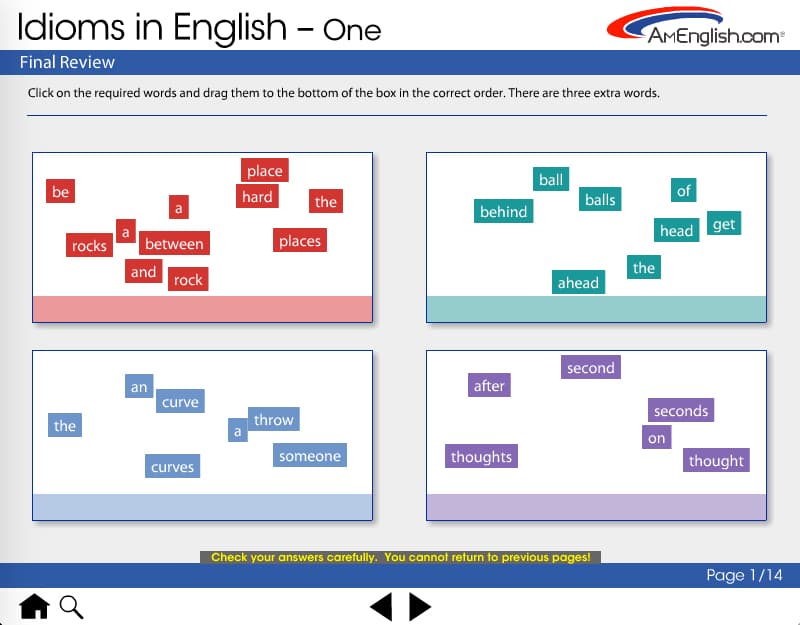
Lesson Eleven: In the Lab
Have students take the Final Review again and see if they can improve their scores.
The Final Review is great practice as it has multiple rotating versions*, and the multiple question types appeal to more than one learning style:
- Word scramble: appeals to kinesthetic/tactile learners
- Dictation: appeals to auditory learners
- Fill-in the blank: appeals to visual learners
- Multiple-choice: appeals to visual learners
*Each version of the Final Review has 100 items with 25 from each category, rotating randomly to cover all 100 idioms. (There are 500 total question items.)
Classroom Expansion Options
Application in e-mail/text exchanges
The instructor can assign e-mail/text exchanges for homework where students use the idioms in context in their communication with each other.
New Idioms
- The instructor can elicit other idioms students hear outside of class.
- These can be compiled and marked for stress and intonation.
Idiom of the Month
The instructor can set up a contest where students keep track of idioms from the course that they hear/read outside of class in terms of frequency. There could be an idiom of the month based on frequency.